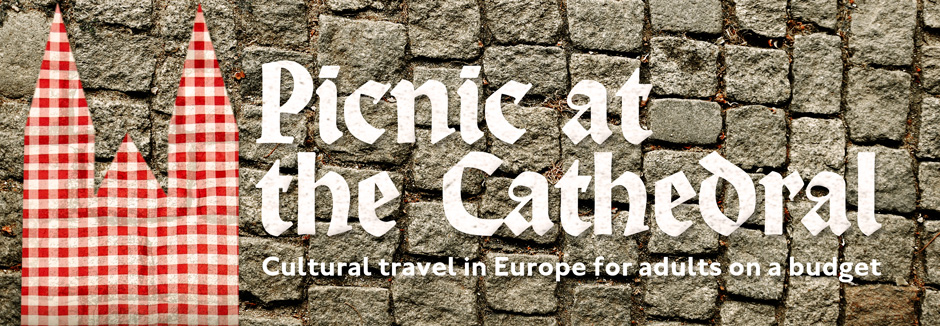The Chancellor of Burgundy, Nicolas Rolin, like a lot of other rich people in the 15th century, was trying to insure his place in heaven through charity to the poor. He founded Hospices de Beaune (also known as Hôtel-Dieu) in 1443 as an almshouse during a time of terrible famine and disease. Most American guidebooks call this poorhouse a hospital, but my sense is it really was a hospice–a place poor people went to die. Only later (remarkably Hôtel-Dieu was still taking patients into the 1970’s) did it become a hospital where people might actually be cured and not just death’s high Gothic waiting room.
A highlight of this hospice-turned-museum is Rogier Van der Weyden’s ginormous 15th century altar painting The Last Judgment. The painting was commissioned for the hospital and used to be displayed in the great hall where patients could see it from their beds, though currently it is in a separate room. With my 21st century eyes, the idea of dying destitute in a red-velvet curtained four poster bed under whimsical wood carvings while facing a graphic rendition of the Last Judgement is downright bizarre, but perhaps the presence of the Van der Weyden’s masterpiece at least served as a distraction to the suffering poor.
Beaune was our least favorite town in Burgundy. No doubt there are attractions for rich wine tourists, but if you don’t have a lot of money to blow on wine, tour Hôtel-Dieu, hunt down some Époisses cheese at the splendid farmer’s market, and then move on to more satisfying and budget friendly towns in Burgundy.
Courtyard of Hôtel-Dieu in High Gothic Burgundian. HOB says “Whoa–check out those gables!”
The polychrome roof is tessellated work of art.
The Grande Salle–great hall of the poor–still has it’s original furniture. At least two patients were in each bed (yeah, so, not a smart way to control infectious disease but no one knew how disease was spread in the 15th century). Mass was held at the end of the hall in a chapel right behind the wood screen so the patients could attend without getting out of bed. Wealthier patients were in a different area of the hospital with more privacy and only on person per bed.
The beams and wooden vaulted ceiling are delightfully painted, with carved dragon heads swallowing the ends of the beam and grimacing peasant heads.
 Our photos of Rogier Van der Weyden’s altar painting The Last Judgment, are crappy–check out this interactive website to get a better look. (At the hospice there’s a giant sliding magnifying glass that the hospice staff will move about so you can study the fascinating details of the painting).
Our photos of Rogier Van der Weyden’s altar painting The Last Judgment, are crappy–check out this interactive website to get a better look. (At the hospice there’s a giant sliding magnifying glass that the hospice staff will move about so you can study the fascinating details of the painting).
In addition to the great hall, we toured Hôtel-Dieu‘s former kitchen and pharmacy as well as a small museum of antique surgical implements. RE the surgical instruments: be very grateful you live in an era of modern medicine.
I’m fairly certain the urinals at Hospices de Beaune were not installed in 1443.
How we got to Beaune: train from Dijon.
Where we slept: Hotel De France Logis. Price: €60 for a double. Recommended: yes.











The colored roofs remind me of the roof of St. Stephen’s Cathedral in Vienna. Even if the works on the Cathedral started in the 12th century, its roof was only made around the 15th century. Colored tiles on roofs seemed to be en vogue at the time 🙂
LikeLike
So true–and the roof of St. Stephen’s is gorgeous!
LikeLike
I appreciate your down-to-earth, honest advice. If I ever head to Europe, I’ll study your blog in preparation. I checked out the interactive website on the Van der Weyden piece. Thanks for pointing the way.
LikeLike
Thanks for your kind words, Cheryl. I hope you do head to Europe so I can see what you discover!
LikeLike
I always wondered where this altarpiece was, I always read it was in a hospital but, I never read this much about it! Was the altarpiece always in its opened state while you were there? Thanks for the great find. I’ve always wanted to see this piece in person and now I’ll know where to go
LikeLike
They have it disassembled so you can see all the parts at once.
LikeLike
Hey WOB, I love your blog and particularly this post about the Hospices De Beaune. We were there a year ago and I did a blog post also with images of the dragons head and peasants head mouth agape! Looking forward to more of your travels!! Best regards from Melbourne!
LikeLike
Thank you for the compliment Michael Evans. With your considerable photography skills, I’m sure you took some wonderful photos of the Hospices!
LikeLike